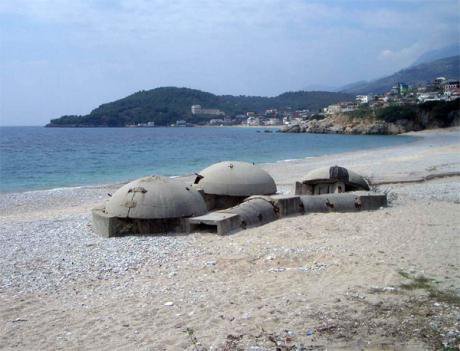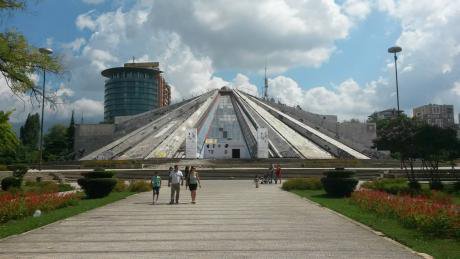
Between 1944 and 1985, the small Balkan nation of Albania was ruled by a strange, sociopathic and, frankly, completely mad dictator by the name of Enver Hoxha. While Stalinism effectively ended in Europe with the death of its namesake, or at least with the Khruschev reforms that followed, it continued unabated and unquestioned in Albania until 1990.
When Hoxha died in 1985, Albania was officially the third poorest country in the world, with the GNP of a small town and an average income of 15 USD a month. Four decades of collectivisation had led to near starvation in the countryside, where Hoxha’s aggressive isolationism meant people were still using farming technology from the 1920s. When the regime finally collapsed a few years after Hoxha’s death, it left behind a tired, hungry, confused and fearful population.
As Albanians marched towards democracy, like proverbial moles blinking into the sunlight, few had the time or will to reflect upon the man who had ruled them with unimaginable cruelty for over four decades.
Enver Hoxha: The Iron Fist of Albania, by the journalist Blendi Fevziu, is the first proper biography of the dictator to be published. Having proven both hugely popular and hugely controversial in his homeland, it arrives here in English for the first time.

Gjirokaster – where Hoxha was born and raised (click to enlarge). Photo by Alex Sakalis. CC.
Enver Hoxha was born in the southern Albanian town of Gjirokaster (then part of the Ottoman Empire) in 1908. He seems to have shunned his father, a simple minded Imam who abandoned him in his youth to go work in the United States for several years, in favour of his uncle Hysen Hoxha, the town’s mayor and a radical atheist and anti-colonialist.
Despite this, Fevziu argues that Hoxha seems to have shown little interest in politics either here or at his secondary school in Korça. He left to study botany at the University of Montpellier despite, in his own words, having no interest in the subject. He abandoned his studies and travelled to Paris where he passed himself off as a representative of the Albanian communist movement and ingratiated himself into the city’s social circle of communist publishers and avant-garde artists.
While there, he attended the notoriously debauched parties of Marxist socialite Paul Vaillant-Couturier. It was perhaps here that Hoxha first tabulated his political beliefs. He was to remain an ardent Francophile throughout his life – one of the few countries he maintained any sort of relationship with.
After returning to Albania, Hoxha worked a few odd jobs before getting involved with the Albanian resistance during World War II. Within a few years Hoxha – a little known and even less liked character – had somehow maneuvered himself into the Party leadership.
How he accomplished this is, by Fevziu’s own admission, “one of the greatest mysteries in Albanian history”. Much of it seems to be down to his chance friendship with two mysterious Yugoslav agents who effectively ran the Albanian Communist Party as a proxy of Tito’s Partisans.
Fevziu’s spends a large amount of time on this particular chapter, and suggests that the Yugoslavs were instrumental in bringing Hoxha to power and helping him consolidate it in the manic post-war years. Despite this, Hoxha broke ties with Tito in 1948 along with the rest of the Warsaw Pact.
He would later break with the USSR (Khruschev was a traitor and revisionist, he claimed) forming an unlikely alliance with China which lasted until that country’s opening to the west in the 1970s. When Hoxha split from China in 1978, Albania was well and truly flying solo.

One depressing leitmotif which recurs throughout the book is Hoxha’s paranoid purges. At the beginning, they make some contextual sense. Of course he would execute collaborators and political opponents – that’s just how things went.
But soon he begins to execute rivals in his own party – including those he had only a few years earlier commended as war heroes. All dissidents were crushed, as were the clergy and the aristocrats.
Old school friends and high school crushes were also purged; the person that had given Hoxha his scholarship to study in France was executed, as was the friend who let him live rent-free in his Paris apartment.
Former prime ministers, signatories to the Albanian Declaration of Independence in 1912, and founders of the Communist movement were among the many victims of summary executions that were de rigeur until the late 1980s.
Hoxha also bumped off much of the intelligentsia to the extent that, by the time of Hoxha’s death, virtually no one in the Politburo could boast more than a high school education. One of the most dangerous positions to hold during Hoxha’s reign was Minister of the Interior – he killed all of them, bar one.
As one woman – whose husband was executed by Hoxha – explains in the book: many Albanians had great ideas on how to run the country after the liberation – but only Hoxha was willing to kill his own brother-in-law to realise them.
In 1967, Hoxha turned Albania into the world’s first atheist state. He closed down all churches and mosques and even destroyed several religious buildings of priceless cultural value. Clergy were among the most purged of all groups, with few living to tell the tale. In one depressing episode, a priest is executed for the crime of performing a baptism in a couple’s home. Hoxha even banned beards due to their association with Islam and Orthodox Christianity.
He cultivated a cult of personality perhaps only equal to Kim Jong-Il in the twentieth century. His published works, which even by the standards of autohagiography are particularly galling, were mandatory reading in schools.
Hoxha – or Uncle Enver as he liked to be portrayed – fomented his cult by fastidiously rewriting history books to present himself as, among other things, the founder of Albanian communism, the founder of the Albanian Communist Party, and the most important figure in the Partisan struggle. This, of course, raised some eyebrows among veterans of these movements, although only those lucky enough to be based outside Albania would live to tell the tale.
Hoxha also kept his people in a constant state of fear by playing up the threat of a foreign invasion. Following this bluff through, Hoxha had around 750,000 concrete bunkers built across the country, mostly on the coast and along the borders with Greece and Yugoslavia, but also in cities, parks and other seemingly random locations.
As well as costing a large chunk of the country’s GDP, this perpetual paranoia project also took the lives of many of the builders, who were mostly forced labourers. The architect of the bunkers, Josif Zagali, was himself eventually sent to a labour camp, in one of the Hoxha’s regular and largely nonsensical purges.

Bunkers on a beach in Albania. Wikimedia. Elian Stefa, Gyler Mydyti – Concrete Mushrooms Project. CC.
Beginning in the 1960s, Hoxha and other leading Party members began confining themselves to a self-sustaining district of Tirana known as Blloku (literally: the Block). Hermetically sealed from the rest of Albania, Hoxha and his cronies rarely ventured outside, preferring to make all the country’s decisions from inside their living rooms and parlours.
The chapter on Blloku is written with all the dystopian intrigue of a J.G. Ballard story. There are special shops to buy the best groceries and western clothes, a leisure house to view ‘banned’ western films, and pharmacies with western medicine procured by Albanian agents abroad. Every luxury denied to the rest of the country was available in this privileged compound.
However, tenure within the Bllok was by no means guaranteed in these turbulent times, and families would often have their children intermarry among each other to forge alliances and guarantee political security, at times descending into quasi-incestuous engagements. Having your child marry one of Hoxha’s children was the goal to which many families aspired, although considering Hoxha has his own brother-in-law murdered, even that didn’t guarantee safety.
Not that there was any joy inside the Bllok. Paranoia and fear was rife, as families were casually purged when Hoxha felt like it and replaced by families from “outside”, desperate to get into this privileged snowglobe world.
When the son of Mehmet Shehu, who Hoxha was grooming as his successor, decides he wants to marry a girl from outside the Bllok – a sweet volleyball player called Silva Turdiu – it sends shockwaves through the community. As Fevziu writes, “little did [Shehu’s fiancée] know that she had just manoeuvred herself into the eye of a terrible political storm.” The event ends with the engagement called off, the entire Shehu family purged and Mehmet Shehu dead in an apparent suicide.

The former Enver Hoxha museum in Tirana opened after his death. Now a TV studio and bus depot. Photo by Alex Sakalis. CC.
Hoxha – a weird, sociopathic, mass-murdering tyrant – passed away a free man. His death ushered in seven days of unprecedented mourning from his indentured subjects. His memoirs, which ran to 13 volumes, were the mark of a man determined to disprove Oscar Wilde’s famous maxim: that no man is rich enough to buy back his past.
Fevziu’s book doesn’t let this injustice stand. His fastidious research, helped by the opening of the previously sealed Communist archives, lays out the horrors of the man and his regime for all to see.
His book is also important in another way: it provides a voice to the dead, the disappeared, the exiled, and the purged, who are brought to life in a number of absorbing vignettes throughout the book. Giving them a voice and a story, something which Hoxha desperately tried to deny them, is perhaps Fevziu’s most profound achievement.
